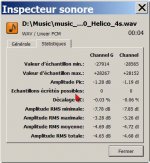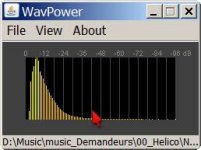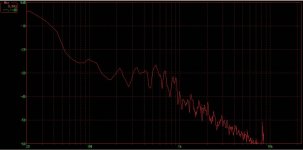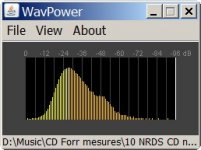That explanation indicates he was referring to overhead inadequacy.
Now what about slew rate inadequacy? What effect will that have on the NFB diff signal?
The NFB diff signal drives the TIM. Essentially, some stage of the amplifier "can't keep up" with the diff signal rate of change. This will, in turn, increase the size of the NFB diff signal, which increases the diff signal rate of change (Etc etc etc)
See also
Otala, Matti and Ensomaa, Raimo 1974 Transient Intermodulation Distortion in Commercial Audio Amplifiers JAES 22(4) pg244-246,
Leinonen, Eero, Otala, Matti, and Curl, John 1977 "A Method for Measuring Transient Intermodulation Distortion (TIM)*" JAES 25(4) pgs170-177
The NFB diff signal drives the TIM. Essentially, some stage of the amplifier "can't keep up" with the diff signal rate of change. This will, in turn, increase the size of the NFB diff signal, which increases the diff signal rate of change (Etc etc etc)
See also
Otala, Matti and Ensomaa, Raimo 1974 Transient Intermodulation Distortion in Commercial Audio Amplifiers JAES 22(4) pg244-246,
Leinonen, Eero, Otala, Matti, and Curl, John 1977 "A Method for Measuring Transient Intermodulation Distortion (TIM)*" JAES 25(4) pgs170-177
See also...
CordellAudio.com - Another View of TIM
forr, none of those links seem to have lists of the CDs with high dynamic range. I believe you have your own list.
Can you post a TXT file with your examples?
This was of great importance to me in my previous life and I had my own lists of commercial CDs. Sadly, I no longer have my list
The only ones I sorta remember are Simon Rattle's recording of Britten's War Requiem and a very old Holst Planets.
Very little pop appears on this list. Most of of my high dynamic range examples are my own unprocessed recordings.
Here is the analysis, using WavPower, of a spectacular recording, containing some clippings which nobody detects if unaware.
It was on the first plage of the first CD-test distributed by a french hi-fi magazine and is a kind of reference for high dynamics.
NRDS CD Test n°01-01
Modeste Moussorgsky 'Tableaux d'une exposition'
James Levine, Metropolitan New-York
Deutsche-Grammophon 437 531-2
2:43
Frequency (Hz): 44100
Time (s): 163
Nb samples: 14406000
Total average (dB): 26.694245003661106
n(1dB) dB population %
0 0dB 11217 0.0778633902540608
1 -1dB 4571 0.03172983479105928
2 -2dB 5909 0.041017631542412884
3 -3dB 7308 0.05072886297376093
4 -4dB 8913 0.06187005414410662
5 -5dB 11127 0.07723865056226573
6 -6dB 13594 0.09436345966958212
7 -7dB 17346 0.12040816326530612
8 -8dB 21710 0.15070109676523671
9 -9dB 28949 0.20095099264195473
10 -10dB 39258 0.27251145356101625
11 -11dB 54083 0.3754199639039289
12 -12dB 73068 0.5072053311120367
13 -13dB 97964 0.6800222129668194
14 -14dB 131312 0.9115090934332917
15 -15dB 168995 1.173087602387894
16 -16dB 207299 1.4389768152158822
17 -17dB 249307 1.730577537137304
18 -18dB 289955 2.0127377481604887
19 -19dB 330244 2.292405941968624
20 -20dB 367842 2.5533944189920867
21 -21dB 398804 2.768318756073858
22 -22dB 425965 2.9568582535054837
23 -23dB 449811 3.122386505622657
24 -24dB 464249 3.222608635290851
25 -25dB 474575 3.2942871025961407
26 -26dB 482084 3.3464112175482437 *** average
27 -27dB 476417 3.3070734416215464
28 -28dB 472700 3.2812716923504097
29 -29dB 460219 3.1946341802026934
30 -30dB 453778 3.1499236429265585
31 -31dB 428541 2.9747396917950852
32 -32dB 419816 2.9141746494516174
33 -33dB 400133 2.777544078856032
34 -34dB 385958 2.6791475773983064
35 -35dB 359411 2.4948701929751493
36 -36dB 351157 2.437574621685409
37 -37dB 328170 2.278009162848813
38 -38dB 311461 2.16202276829099
39 -39dB 291306 2.022115785089546
40 -40dB 266786 1.8519089268360405
41 -41dB 258581 1.794953491600722
42 -42dB 253243 1.7578994863251423
43 -43dB 224464 1.558128557545467
44 -44dB 219747 1.5253852561432737
45 -45dB 209930 1.4572400388726918
46 -46dB 222434 1.5440372067194226
47 -47dB 210273 1.4596209912536444
48 -48dB 213024 1.4787172011661807
49 -49dB 216240 1.5010412328196585
50 -50dB 193906 1.3460086075246425
51 -51dB 166766 1.157614882687769
52 -52dB 164321 1.1406427877273357
53 -53dB 141124 0.9796196029432181
54 -54dB 118523 0.8227335832292101
55 -55dB 114426 0.7942940441482715
56 -56dB 76555 0.5314105233930306
57 -57dB 61962 0.4301124531445231
58 -58dB 71337 0.4951895043731778
59 -59dB 54318 0.3770512286547272
60 -60dB 39938 0.27723170901013466
61 -61dB 40200 0.27905039566847145
62 -62dB 39218 0.272233791475774
63 -63dB 39277 0.27264334305150634
64 -64dB 25585 0.17759961127308066
65 -65dB 25056 0.17392753019575177
66 -66dB 24739 0.17172705817020686
67 -67dB 12707 0.088206302929335
68 -68dB 25032 0.17376093294460643
69 -69dB 12522 0.08692211578508954
70 -70dB 12695 0.08812300430376233
71 -71dB 13011 0.09031653477717617
72 -72dB 12611 0.08753991392475358
73 -73dB 12333 0.08561016243231986
74 -74dB 12191 0.08462446202970984
75 -75dB 0 0.0
76 -76dB 12636 0.08771345272802998
77 -77dB 0 0.0
78 -78dB 12678 0.08800499791753436
79 -79dB 0 0.0
80 -80dB 12067 0.08376370956545884
81 -81dB 0 0.0
82 -82dB 0 0.0
83 -83dB 0 0.0
84 -84dB 11778 0.08175760099958351
85 -85dB 0 0.0
86 -86dB 0 0.0
87 -87dB 0 0.0
88 -88dB 0 0.0
89 -89dB 0 0.0
90 -90dB 7599 0.05274885464389838
91 -91dB 0 0.0
92 -92dB 0 0.0
93 -93dB 0 0.0
94 -94dB 0 0.0
95 (-)infinity 569641 3.954192697487158
Attachments
Here is the analysis, using WavPower, of a spectacular recording, containing some clippings which nobody detects if unaware.
It was on the first plage of the first CD-test distributed by a french hi-fi magazine and is a kind of reference for high dynamics.
NRDS CD Test n°01-01
Modeste Moussorgsky 'Tableaux d'une exposition'
James Levine, Metropolitan New-York
Deutsche-Grammophon 437 531-2
2:43
.... loadsa good but obfuscating stuff ....
Thanks for this forr. But just the CD & track details are sufficient.
The correct way to use this is to
- play it on your system at your preferred level
- note the position of your volume control
- play Pano's test signal at the same volume setting.
Got any more examples?
Got any more examples?
Here is a very interesting file for tests of home hifi system.
It is a short extract of a recording lasting 8' made inside the cabin of an helicopter. It is the most rich and lengthy (180' in all) passage I ever found for extreme low frequencies :
http://iodau.pagesperso-orange.fr/Helico.wav
It does not present clipping, does not sound so load but it is very demanding concerning the cone excursion of the bass drivers.
With a music editor, you can copy and paste it many times to get maybe a 60 s track, more useful for tests.
I join analyses done with OcenAudio, WavPower and WaveSpectra



Wavpower data for "NRDS_CDn°08-10_Helico.wav"
(extract 4 s)
Frequencyb (Hz): 44100
Time (s): 4
Nb samples: 439922
Total average (dB): 8.969402415698186
n(1dB) dB population %
0 0dB 0 0.0
1 -1dB 4608 1.0474584130823192
2 -2dB 21387 4.861543637281154
3 -3dB 27228 6.189279008551516
4 -4dB 30159 6.855533480935256
5 -5dB 34110 7.753647237464823
6 -6dB 34721 7.892535494928646 ***
7 -7dB 33313 7.5724787575979375
8 -8dB 27130 6.167002332231623
9 -9dB 24939 5.668959497365442
10 -10dB 23155 5.2634330631339195
11 -11dB 20265 4.606498424720746
12 -12dB 19114 4.344861134473838
13 -13dB 17072 3.880687940134842
14 -14dB 15047 3.420379067198276
15 -15dB 13263 3.014852632966753
16 -16dB 11910 2.7072981119380253
17 -17dB 10586 2.4063356685957964
18 -18dB 9395 2.135605857401994
19 -19dB 8038 1.8271420842785766
20 -20dB 6852 1.557548838203136
21 -21dB 5771 1.3118234596132952
22 -22dB 5058 1.1497492737348893
23 -23dB 4345 0.9876750878564836
24 -24dB 3685 0.837648492232714
25 -25dB 3314 0.7533153604502616
26 -26dB 2853 0.6485240565372953
27 -27dB 2496 0.5673733070862562
28 -28dB 2195 0.49895208696087034
29 -29dB 1942 0.44144189197175865
30 -30dB 1745 0.3966612263083001
31 -31dB 1496 0.3400602834138779
32 -32dB 1352 0.3073272080050554
33 -33dB 1178 0.2677747418860616
34 -34dB 1036 0.2354962925245839
35 -35dB 969 0.22026631993853457
36 -36dB 846 0.19230681802683203
37 -37dB 760 0.1727578979910075
38 -38dB 677 0.15389091702620009
39 -39dB 592 0.13456931001404795
40 -40dB 618 0.14047944862952977
41 -41dB 501 0.11388382485986152
42 -42dB 460 0.10456399088929401
43 -43dB 393 0.08933401830324467
44 -44dB 336 0.0763771759539191
45 -45dB 334 0.07592254990657435
46 -46dB 313 0.0711489764094544
47 -47dB 263 0.05978332522583549
48 -48dB 192 0.04364410054509663
49 -49dB 221 0.0502361782315956
50 -50dB 179 0.04068903123735571
51 -51dB 151 0.03432426657452912
52 -52dB 159 0.03614277076390815
53 -53dB 127 0.028868754006392043
54 -54dB 120 0.027277562840685395
55 -55dB 124 0.028186814935374907
56 -56dB 66 0.015002659562376966
57 -57dB 86 0.01954892003582453
58 -58dB 82 0.01863966794113502
59 -59dB 64 0.01454803351503221
60 -60dB 53 0.012047590254636049
61 -61dB 47 0.01068371211260178
62 -62dB 55 0.012502216301980805
63 -63dB 45 0.010229086065257022
64 -64dB 30 0.006819390710171349
65 -65dB 35 0.00795595582853324
66 -66dB 38 0.008637894899550375
67 -67dB 21 0.004773573497119944
68 -68dB 28 0.006364764662826592
69 -69dB 18 0.0040916344261028095
70 -70dB 13 0.0029550693077409177
71 -71dB 12 0.0027277562840685395
72 -72dB 14 0.003182382331413296
73 -73dB 18 0.0040916344261028095
74 -74dB 11 0.002500443260396161
75 -75dB 0 0.0
76 -76dB 12 0.0027277562840685395
77 -77dB 0 0.0
78 -78dB 19 0.004318947449775188
79 -79dB 0 0.0
80 -80dB 17 0.003864321402430431
81 -81dB 0 0.0
82 -82dB 0 0.0
83 -83dB 0 0.0
84 -84dB 20 0.004546260473447566
85 -85dB 0 0.0
86 -86dB 0 0.0
87 -87dB 0 0.0
88 -88dB 0 0.0
89 -89dB 0 0.0
90 -90dB 19 0.004318947449775188
91 -91dB 0 0.0
92 -92dB 0 0.0
93 -93dB 0 0.0
94 -94dB 0 0.0
95 (-)infinity 6 0.0013638781420342698
n(3dB) dB population %
0 0dB 25995 5.9090020503634735
3 -3dB 91497 20.798459726951595
6 -6dB 95164 21.632016584758208 ***
9 -9dB 68359 15.538890985220107
12 -12dB 51233 11.645928141806957
15 -15dB 35759 8.128486413500575
18 -18dB 24285 5.520296779883707
21 -21dB 15174 3.449247821204668
24 -24dB 9852 2.239487909220271
27 -27dB 6633 1.507767286018885
30 -30dB 4593 1.0440487177272335
33 -33dB 3183 0.7235373543491801
36 -36dB 2283 0.5189556330440396
39 -39dB 1711 0.38893258350343923
42 -42dB 1189 0.27027518514645776
45 -45dB 910 0.20685485154186423
48 -48dB 592 0.13456931001404795
51 -51dB 437 0.09933579134482931
54 -54dB 310 0.07046703733843727
57 -57dB 232 0.052736621491991764
60 -60dB 155 0.03523351866921864
63 -63dB 110 0.02500443260396161
66 -66dB 87 0.01977623305949691
69 -69dB 43 0.009774460017912266
72 -72dB 43 0.009774460017912266
75 -75dB 12 0.0027277562840685395
78 -78dB 36 0.008183268852205619
81 -81dB 0 0.0
84 -84dB 20 0.004546260473447566
87 -87dB 0 0.0
90 -90dB 19 0.004318947449775188
93 -93dB 6 0.0013638781420342698
Last edited:
I was hoping for musical examples.Here is a very interesting file for tests of home hifi system.
It is a short extract of a recording lasting 8' made inside the cabin of an helicopter. It is the most rich and lengthy (180' in all) passage I ever found for extreme low frequencies :
http://iodau.pagesperso-orange.fr/Helico.wav
forr, what spl do YOU play it at on YOUR system? Is that the correct level?
I suggest 'The Garage Door' is a more musical example that will place similar demands on your bass units. Also, it is easier to compare with 'real life' as many people have garage doors while very few have helicopters.
But 'The Garage Door' is a 'once in a lifetime' experience at the correct level. Consult your doctor if you are old, infirm or not in the best of health.
Consult your doctor if you are old, infirm or not in the best of health.
Thanks for your nice suggestion.
I gave the links to get the freeware analysis tools for any WAV records so you can publish results just as I do.I was hoping for musical examples.
Musical examples are not necessarily the most difficult ones.
I select typical very demanding records to give information about what listeners at home can expect from their sound reproduction system.
I'll be happy not to be alone to be interested in data on the subject and to publish some.
When my system is set high in my small room, listening distance at 2 m, my medium speakers (86 dB / 2.83 V / 1 m, 160 - 2000 Hz) has peaks voltages at around 5.6 V. This gives an average listening level of 70 -75 dB, which is the most often used in domestic environments.
As the driving amp is able to deliver +/- 24 Vpk, there is a comfortable 12 dB margin before clipping.
I am a typical average listener.
Last edited:
Is this with your helicopter example?When my system is set high in my small room, listening distance at 2 m, my medium speakers (86 dB / 2.83 V / 1 m, 160 - 2000 Hz) has peaks voltages at around 5.6 V. This gives an average listening level of 70 -75 dB, which is the most often used in domestic environments.
As the driving amp is able to deliver +/- 24 Vpk, there is a comfortable 12 dB margin before clipping.
_________________
'The Garage Door' is probably the most famous Soundfield recording ever made. It was the final track in the first HFN & RR demo CD. Recorded by Mike Skeet.
Is this with your helicopter example?
No.
forr's speaker system?
forr, I would really like to know the details of your speaker system that I asked about in #909 of the CFA topology thread
____________________
Some posts back, I suggested going to a concert with an spl meter. That advice is obviously (to true gurus) rubbish. SPL meters have serious averaging so useless to find your peak requirements.
To obtain information on our subject "will your amp clip?" what you need is a Peak & Hold meter and calibrated mike. Some B&K mike amps have this facility with (much) less than 1ms rise time. They are $$$ but today, a Schoeps MK2 and good digital recorder like a Sound Devices will do the trick at slightly less $$. Make a note of the Record Level knob so you can calculate absolute peak levels.
But the spl meter is probably OK for pop concerts cos pop recordings are even more compressed than pop concerts.
forr, I would really like to know the details of your speaker system that I asked about in #909 of the CFA topology thread
____________________
Some posts back, I suggested going to a concert with an spl meter. That advice is obviously (to true gurus) rubbish. SPL meters have serious averaging so useless to find your peak requirements.
To obtain information on our subject "will your amp clip?" what you need is a Peak & Hold meter and calibrated mike. Some B&K mike amps have this facility with (much) less than 1ms rise time. They are $$$ but today, a Schoeps MK2 and good digital recorder like a Sound Devices will do the trick at slightly less $$. Make a note of the Record Level knob so you can calculate absolute peak levels.
But the spl meter is probably OK for pop concerts cos pop recordings are even more compressed than pop concerts.
Last edited:
forr, I would really like to know the details of your speaker system that I asked about in #909 of the CFA topology thread
I think I already gave these details :
Stereo 2 channels, loudspeaker 3 ways, with amps driven by a digital processor.
amps : bass 60 or 100 W / 8 Ohm, medium and treble 25 W /8 Ohm
drivers : bass 31 and 38 cm, medium cone 17 cm, treble dome 28 mm.
I go to concerts to listen music not to measure SPL peaks. When the instruments are only acoustic, I never suffer from too high SPLs.Some posts back, I suggested going to a concert with an spl meter. That advice is obviously (to true gurus) rubbish. SPL meters have serious averaging so useless to find your peak requirements.
I often do when there are amplified instruments during rock and the like concerts where SPLs can be really painful and mask the real qualities of the music.
My system is able to deliver SPLs much higher than I can tolerate, it can go louder than the level at a comfortable seat at an acoustical concert.
As the highest levels obtained from digital records are limited by their 0 dBFS, it is very easy to know if a reproducing system is going to be clipped by the voltages provided at the output of the D/A converters, and then to avoid that power amps ever clip .
When an amplifier clips, it goes out of the territory of high fidelity.
For a well mastered, normally working, domestic hifi system, we never have to bother of the clipping behaviour of the amps, it is definitely not a criterion of quality.
Having a clean clipping behaviour with fast recovery can be obtained for most amps with relatively simple additional circuits, see Bob Cordell's book for example.
However, in case of need, I would prefer to have a 200 W amp with slow recovery from clipping than a 50 W amp with smooth clipping and fast recovery.
To know if an amplifier will clip, a high quality multimeter with a Peak & Hold meter and an oscilloscope suffice. I do not see the role of a mike in such tests.To obtain information on our subject "will your amp clip?" what you need is a Peak & Hold meter and calibrated mike.
I own a B&K sonometer. Not much used yet.Some B&K mike amps have this facility with (much) less than 1ms rise time. They are $$$ but today, a Schoeps MK2 and good digital recorder like a Sound Devices will do the trick at slightly less $$. Make a note of the Record Level knob so you can calculate absolute peak levels.
I already gave some data on different musics, I am still looking for yours.
I am also interested to know what maximal slew rates should be, and why, according to CFA freaks and what they are in the proposed circuits.
Last edited:
I have designed and auditioned CFA and Vfb amps and the implementation seems fairly fine in subjective assessment. My latest uses CFA topology, but the details of the three stages seem to dominate rather more than the CFB approach.
You can talk long about the technical details, finesse slew rates etc but if you ignore the subjective results, the audition if you will, the goal for the amp remains illusory. This is psychoacoustics, something most do not think about because they are determined to reduce THD. After all, it is very difficult to be objective about the subjective, and 90% of audiophiles, even higher non-tech people, are concerned with the subjective, 'how it sounds'.
Another problem is that people have different preferences. I have one friend who routinely ignores SS amps, he only wants a SET with a directly heated cathode. Nothing else will do it for him....... yesterday in a café he wanted me to help with a tube preamp, and we could not even agree on what tube to select, we did not even get to first base!!
I try not to get too upset about diametrical views. There are lots around, many of them with flawed logical argument. Yet they are all audiophiles.........
Ciao,
Hugh
You can talk long about the technical details, finesse slew rates etc but if you ignore the subjective results, the audition if you will, the goal for the amp remains illusory. This is psychoacoustics, something most do not think about because they are determined to reduce THD. After all, it is very difficult to be objective about the subjective, and 90% of audiophiles, even higher non-tech people, are concerned with the subjective, 'how it sounds'.
Another problem is that people have different preferences. I have one friend who routinely ignores SS amps, he only wants a SET with a directly heated cathode. Nothing else will do it for him....... yesterday in a café he wanted me to help with a tube preamp, and we could not even agree on what tube to select, we did not even get to first base!!
I try not to get too upset about diametrical views. There are lots around, many of them with flawed logical argument. Yet they are all audiophiles.........
Ciao,
Hugh
Last edited:
" This gives an average listening level of 70 -75 dB, which is the most often used in domestic environments."
Interesting
MY room's ambient is 54db with the window AC unit on fan only
78db is the quietness I'll play my system to hide that wife prefers it at 73.
When she is not home or in another room I prefer 84db according to my Ipad and I'm 2 meters from my bose 901 speakers with a Yamaha RX992 (in stereo mode) for a pre amp and a carver pm700 for the power amp.
Now when someone wants to hear the system cranked or I feel like rocking 95db is about as much as I can handle in my 12x16 room
Interesting
MY room's ambient is 54db with the window AC unit on fan only
78db is the quietness I'll play my system to hide that wife prefers it at 73.
When she is not home or in another room I prefer 84db according to my Ipad and I'm 2 meters from my bose 901 speakers with a Yamaha RX992 (in stereo mode) for a pre amp and a carver pm700 for the power amp.
Now when someone wants to hear the system cranked or I feel like rocking 95db is about as much as I can handle in my 12x16 room
What is the final sensitivity of your medium 17cm cone in the completed system? What is the xover frequency between that and your 2 bass units?amps : bass 60 or 100 W / 8 Ohm, medium and treble 25 W /8 Ohm
drivers : bass 31 and 38 cm, medium cone 17 cm, treble dome 28 mm.
Do you have a passive xover between that and your 28mm dome?
________________
BTW, the B&K sonometer is useless for checking peak levels with the Time Constants & accuracy we need.
Last edited:
I agree with the level of 110dB peak being perfectly adequate in a domestic situation - IME there are no issues with a system 'only' capable of going that loud. However - and this is a mightly big however  - that peak has to be reached cleanly, without distortion, 'compression', apparent clipping, 'stressing'. With the vast majority of audio systems this does not happen, the subjective quality degrades as that peak is approached, the sound is not 'effortless' - note, the latter is often the term used to describe non-faulty playback, and is remarked upon because it's so rare, usually ...
- that peak has to be reached cleanly, without distortion, 'compression', apparent clipping, 'stressing'. With the vast majority of audio systems this does not happen, the subjective quality degrades as that peak is approached, the sound is not 'effortless' - note, the latter is often the term used to describe non-faulty playback, and is remarked upon because it's so rare, usually ...
The normal hifi experience is that when the volume is turned up, people instinctively inwardly clench when a crescendo is almost upon them, because they 'know', from experience, that it will be 'a bumpy ride'. This is not what should happen, it's a giveaway that the system is not working properly.
If all is in order then the listeners will be quite oblivious to the fact that the system is reaching max SPL peaks - it will just sound 'normal' ...
The normal hifi experience is that when the volume is turned up, people instinctively inwardly clench when a crescendo is almost upon them, because they 'know', from experience, that it will be 'a bumpy ride'. This is not what should happen, it's a giveaway that the system is not working properly.
If all is in order then the listeners will be quite oblivious to the fact that the system is reaching max SPL peaks - it will just sound 'normal' ...
What is the final sensitivity of your medium 17cm cone in the completed system? What is the xover frequency between that and your 2 bass units?
Do you have a passive xover between that and your 28mm dome?
The 17 cm is a ScanSpeak Revelator, with a sensitivity of 86 dB / 2.83 V / 1 m. It is often considered as one of the best medium drivers in the world.
Crossovers at 160 and 2000 Hz belong to the quasi-optimal kind which aims is to minimize group delays. Tweaking with "bell" and "shelf" settings, I could include the hi-pass behavior of the drivers in the filtering.
The 28 mm tweeter is also a ScanSpeak, 90 dB / 2.83 V / 1 m.
If you had more carefully read my previous post, you'd know that it also has its own amp actively filtered by the digital processor.
- Status
- This old topic is closed. If you want to reopen this topic, contact a moderator using the "Report Post" button.
- Home
- Amplifiers
- Solid State
- Power amps, dynamics and sound levels at home
